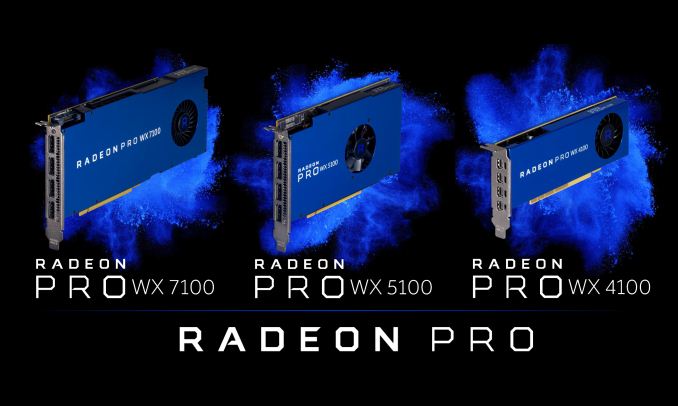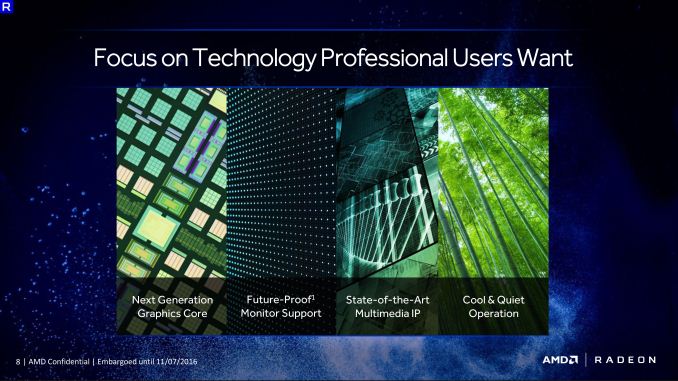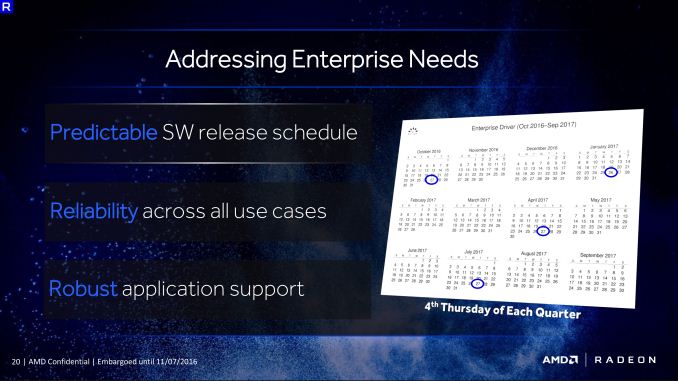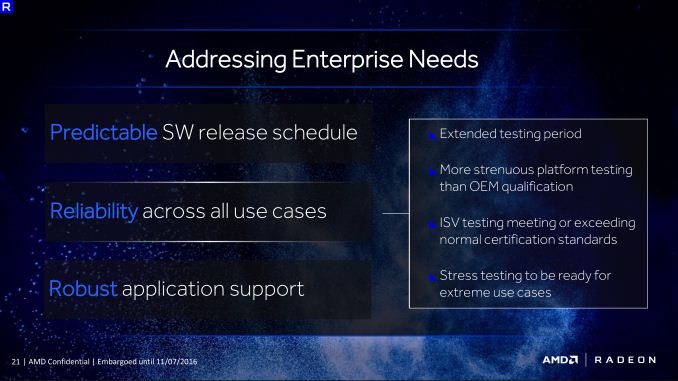Now Shipping: AMD Radeon Pro WX Series
by Ryan Smith on November 7, 2016 9:00 AM EST- Posted in
- GPUs
- AMD
- Polaris
- Radeon Pro

Back in July AMD announced the Radeon Pro WX series. Part of a broader rebranding effort for AMD’s professional grade graphics cards – moving away from the FirePro brand and making everything part of the Radeon family – the WX series would also mark the first use of AMD’s latest-generation Polaris architecture in their pro cards. At the time of their announcement, AMD had not finalized the card specifications or launch date beyond Q4, but as of this week the cards are finally reaching AMD’s partners and retailers, and the final specifications are being released.
| AMD Workstation Video Card Specification Comparison | ||||||
| WX 7100 | W7100 | WX 5100 | WX 4100 | |||
| Stream Processors | 2304 | 1792 | 1792 | 1024 | ||
| Texture Units | 144 | 112 | 112 | 64 | ||
| ROPs | 32 | 32 | 32 | 16 | ||
| Boost Clock | ~1.24GHz | 920MHz | ~1.09GHz | ~1.17GHz | ||
| Memory Clock | ? | 5Gbps GDDR5 | ? | ? | ||
| Memory Bus Width | 256-bit | 256-bit | 256-bit | 128-bit | ||
| VRAM | 8GB | 8GB | 8GB | 4GB | ||
| TBP | 130W | 150W | 75W | 50W | ||
| Width | Single | Single | Single | Single | ||
| GPU | Polaris 10 | Tonga | Polaris 10 | Polaris 11 | ||
| Architecture | Polaris | GCN 1.2 | Polaris | Polaris | ||
| Manufacturing Process | GloFo 14nm | TSMC 28nm | GloFo 14nm | GloFo 14nm | ||
| Launch Date | 11/10/2016 | 08/2014 | 11/18/2016 | 11/10/2016 | ||
| Launch Price (MSRP) | $799 | N/A | $499 | $399 | ||
When AMD first announced these cards, they were targeting better than 2 TFLOPS, 4 TFLOPS, and 5 TFLOPS for the WX 4100, WX 5100, and WX 7100 respectively. The final specifications put the WX 7100 and WX 4100 ahead of that, at 5.7 and 2.4 TFLOPS. However the WX 5100 ended up coming up a bit short of AMD’s goal; it tops out at 3.9 TFLOPS.
Otherwise the cards have not significantly changed since AMD’s initial unveiling. Though along with the final specifications, we also have the final TBPs. The top-tier WX 7100 is rated for 130W, while the WX 5100 becomes AMD’s pro card of choice for 75W systems that don’t offer an external power connection. Finally the low-end WX 4100 is being rated at 50W. Meanwhile AMD is going for a single-wide cards across the entire family, something they also did with the 150W-and-below members of the previous-generation FirePro series.
Finally, when it comes to pricing AMD indicated that they’d continue to be very competitive with NVIDIA here, and the final prices reflect that. The WX 7100 will be hitting the market at $799, with the WX 5100 and WX 4100 bringing up the rear at $499 and $399 respectively. AMD has over the last couple of generations aimed to offer better performance-per-dollar than NVIDIA in this space, and the Radeon Pro WX series is continuing this tradition. The high-end WX 7100 and low-end WX 4100 will be available later this week on the 10th, while the mid-range WX 5100 will hit the virtual shelves later next week on the 18th.
Driver News: Quarterly Releases for Pro Drivers
Along with this week’s launch of the Radeon Pro WX series cards, AMD is also further clarifying their plans for software support of the new hardware. Even with the change in branding, the Radeon Pro WX series is still getting its own, separate enterprise driver release.
The biggest shift here is that AMD is now going to be releasing drivers on a set schedule; they will be releasing drivers quarterly, on the fourth Thursday of each quarter. In fact this new schedule is being applied to all AMD pro cards, including their existing FirePro cards, with their most recent driver release on October 27th (driver 16.Q4) serving as the first release under this schedule. AMD hopes that by offering drivers on a fixed release schedule, they can strike a balance between updates and stability for pro users, giving pro users regular updates while avoiding the disarray that can come from unexpected driver releases.
AMD is also reiterating their focus on reliability and driver quality. Besides getting drivers certified by the usual parties in the pro application space – Autodesk, Adobe, Dassault Systèmes, etc – they are also doing their own internal testing, the idea being to exceed what their OEM partners are already doing. From a market share perspective AMD is still the underdog by a significant margin, so it's important they show potential customers that they can meet or beat NVIDIA on support and reliability, as well as performance.



















32 Comments
View All Comments
BrokenCrayons - Monday, November 7, 2016 - link
It's evident that a 150W card doesn't need a dual slot cooling solution thanks to the WX series. It's disappointing to see consumer cards don't follow suit.fanofanand - Monday, November 7, 2016 - link
That depends on clock speeds but on the surface I would agree.Valantar - Monday, November 7, 2016 - link
Noise is a big differentiator too. Enterprise/professional cards are usually far noisier than would be considered acceptable for home use.BrokenCrayons - Monday, November 7, 2016 - link
Maybe, but I'd like to see an acoustic analysis before reaching any conclusions about the noise the cards make. This isn't server room/rack mount hardware where shrieking fans are the norm. These cards will end up in workstations and they really can't scream incessantly. I suspect that at least the WX 5100 and 4100 won't be significantly louder than the dual slot cards we see in the consumer segment.barleyguy - Tuesday, November 8, 2016 - link
This has not been my experience at all. I own a FirePro V7900, and have used a significant number of the FirePro and Quadro cards (because my former employer generally used "workstation" machines that came with these type of cards), and in my experience they aren't categorically noisier than consumer cards.They do possibly put more heat into the case, as someone noted below. But workstation class machines from companies like Dell and HP generally have really good thermal design, so the net noise of the machine is very low actually.
In short, these are great cards if you design a system around them; either buy them in a well designed machine or buy a case that has good thermal design, and they shouldn't have any noise or thermal issues.
$.02
coder543 - Monday, November 7, 2016 - link
How does that depend on the clock speeds? If the card is rated to dissipate 150W, it will dissipate 150W. If you have a GPU that can run at 2 terahertz, and it only generates 150W, it will be just fine. If you have a GPU that runs at 2 kilohertz and it somehow generates 150W, it will also be just fine. The clockspeed doesn't matter, only the amount of heat that the card generates.Alexvrb - Monday, November 7, 2016 - link
The boost clocks may be higher on consumer cards, particularly aftermarket solutions that make up the majority of sales. Those aftermarket solutions may also blow past the reference TDP.Anyway the biggest issue is that professional often assume lots of case cooling and thus expel FAR more hot air into the case vs an equivalent twin slot desktop consumer card. Although some consumer cards dump more hot air into your case than others, these cards are on a whole different level. Look at the pics. Even removing some connections wouldn't help you enough to match even the most mediocre dual-slot cooling solutions.
That doesn't even factor in overclocking. I for one would have zero desire for a single slot 150W card. Clearly the market demand is low.
Tabalan - Tuesday, November 8, 2016 - link
Overclocking in workstation? Hahaha, good joke. Plus low market demand for pro or semipro GPU? Like almost every workstation out there uses one of such? This is not for gaming, it's for work, to speed up CAD/CAM/CAE programmes. Noone cares if you want this card, managers/directors will order to buy several or even hundreds of these per bigger company and Nvidia/AMD will be completely fine.Alexvrb - Tuesday, November 8, 2016 - link
You took everything I said out of context. If you read the previous comments in this chain, you'd know I was talking about why they don't make 150W consumer cards that are single slot. The OP said:"It's evident that a 150W card doesn't need a dual slot cooling solution thanks to the WX series. It's disappointing to see consumer cards don't follow suit."
So in this chain we were talking about why consumer cards don't use single slot solutions at 150W like workstation cards. To reiterate: Workstations have better chassis cooling than a typical consumer rig and don't overclock. That is why it is acceptable to go with a single slot solution in a workstation but less appealing in a regular desktop card in this thermal range. When I was talking about low demand, I was talking again about consumer cards. If demand was there, you would see single slot cards in the consumer space at this output level. Sorry if that wasn't clear from the context of the conversation.
Anato - Tuesday, November 8, 2016 - link
That 150W 2THz silicon would be size of pinhead and 150W 2kHz silicon would be size of whole card. So Hz matters as its related to silicon area where heat is dissipated, which is related to cooling requirements. Then there is price, you can make better fans and cooling systems with more money.